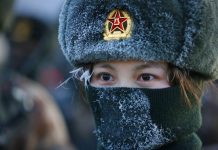Is a US-China Conflict really inevitable? US-China Trade War was just the beginning, but experts at EurAsian Times see a further escalation of conflict between world’s two biggest powers, US and China. The Chinese leadership have realized (lessons drawn from USSR debacle) that its security is affected not only by the military forces of other countries but also by political, economic, societal and environmental factors in international relations.
Aggressive China Thwarting the US in the Battle for Global Dominance?
The impressive growth of China’s defence, latest being the construction of its third aircraft carrier, which EurAsian Times reported earlier, has turned heads of many world leaders and even set rumours rolling that Beijing would claim military victory in a potential Sino-American war.
In a new study, RAND Corp. has revealed that the People’s Liberation Army (PLA) is focused on competing as a means to achieving the policy outcomes identified by the Communist Party of China, deterring US intervention and defeating the US military if the United States and China do come into an open conflict.
Lessons from the Cold War
During the Cold War, the Soviet Union bankrupted itself with an obsessive need to match US capabilities such as ballistic missile defense. China has keenly studied this and will not make the same mistakes. When the Soviet Empire and the East European communist regimes collapsed, the structure of the postwar international system dissolved, and the old parameters for China’s security strategy disappeared.
The Chinese leadership suddenly found itself in a totally new world in which China needed to reorient and redefine its security strategy on a new strategic axis.
Chinese experts say that Beijing’s security strategy after the cold war is redefined by its domestic priorities, growing foreign economic relations, the new security environment in Asia, and concerns over territorial disputes.
Over the years, Chinese leadership have realized that its security is affected not only by the military forces of other countries, but also by political, economic, societal and environmental factors in international relations.
China’s Defence Growth
RAND sees the growth of Chinese air and missile power over the last decade, which Beijing sees as an achievement, fueled by relentless copying or as a matter of fact, ‘stealing foreign technology’.
The study states that “when the PLA finds problems that it cannot solve through copying, it has proven sufficiently resourceful to develop innovative solutions to its operational challenges, creating entirely new capabilities or operating in new and creative ways to frustrate the ability of the United States and other advanced militaries to operate in proximity to Chinese shores.”
The outcome is very impressive as China is all geared-up to counter the US dominance not only militarily, but economically and diplomatically as well.
More News at EurAsian Times
- Indian Military Base in Sabang can Strangle China at the Strait of Malacca
- India-US 2+2 Dialogue: India Needs to choose Between US and Russia
- Is Saudi-UAE Alliance Working to Weaken the Gulf Cooperation Council?
- From Asia to Africa, India-Japan Defence Partnership Aggressively Countering China




